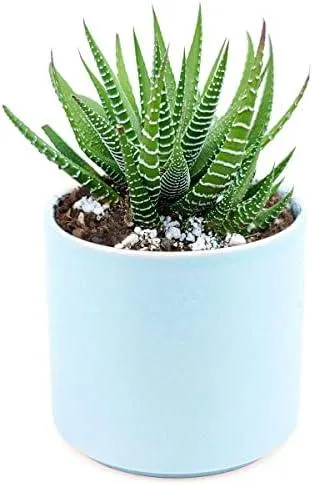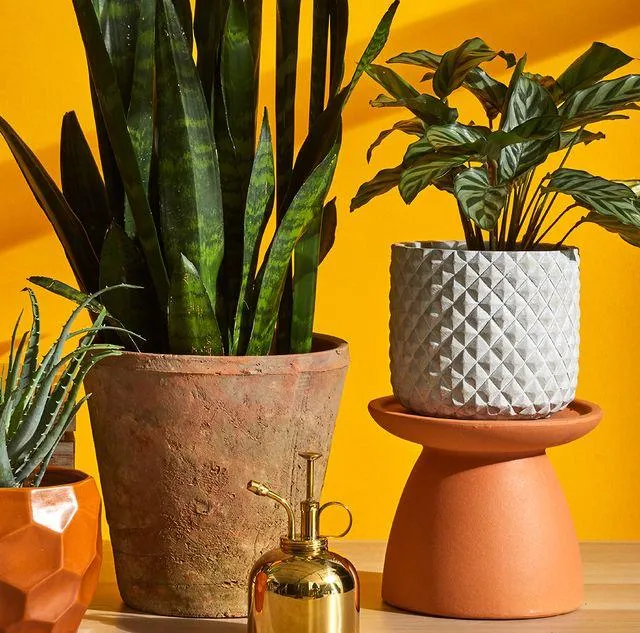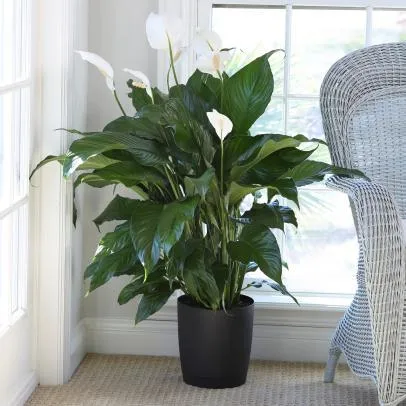Indoor Plants That Thrive Without Direct Sunlight
If you live in an apartment or home with limited natural light, you may wonder which types of indoor plants you can successfully grow without direct sunlight. From my experience as an avid gardener, there are definitely options that will flourish even in low-light conditions.
Pothos
Pothos, also known as devil’s ivy, is one of the hardiest and most forgiving houseplants you can own. I’ve had pothos plants survive in basement windows that got sun only an hour per day. They’re pretty tough! Pothos vines grow long trails that look beautiful draped around shelves, hanging pots, or winding up a moss pole. Their heart-shaped leaves come in both solid green and variegated forms with splotches of yellow or white. Water them when the soil starts to dry out.
Snake Plant
Another excellent choice for low-light spots is the snake plant. Its stiff, upright leaves with yellow variegation make for an attractive accent in any indoor space. Some say snake plants are nearly impossible to kill – they can go a month or more between waterings! They also release oxygen at night, so they make great air-purifying plants. I keep a few snake plants in my living room, which only gets indirect sun through large west-facing windows in the afternoons.

Chinese Evergreen
Chinese evergreen, or aglaonema, comes in a kaleidoscope of colorful leaf patterns sure to brighten any room. I have a burgundy-leaved variety that thrives on my north-facing kitchen windowsill. These plants prefer partial shade and can go a while sans water, making them low-maintenance despite their tropical appearance. Just be careful not to overwater, as soggy soil causes leaf drop.
Peperomia
If you love unique leaf textures and shapes, consider peperomia. These botanical beauties come in an array of designs like rippled, pleated, or rounded. My peperomia ornata has smooth oval leaves blending shades of lime green and pink – it’s a real stunner! Peperomias handle low light well and like to dry out slightly between waterings. They make excellent tabletop plants or filler for shaded spots in your home.
ZZ Plant
Also called zanzibar gem, the ZZ plant thrives on neglect! In fact, overwatering is its biggest disease. I barely water mine once a month, even in dense shade. Its thick, waxy leaves coated in a deep emerald hue withstand drought and shade with aplomb. ZZ plants tolerate all indoor conditions, from direct sun to very low light. Their undemanding nature makes them ideal for busy folks or those new to plant parenthood.

Cast Iron Plant
True to its name, the cast iron plant can seemingly endure anything – including an absence of direct sun. Its lance-shaped, dark green leaves hold up well in low-light corners and make an attractive, low-maintenance accent. These plants prefer humidity, so misting their foliage regularly works wonders. Cast iron plants like slightly drier soil too, so resist the urge to overwater. I can confess times I’ve been negligent, yet mine always bounce back.
Peace Lily
Beautiful peace lilies flourish in indirect bright light and thrive on neglect. I have one peace lily that’s survived for over 5 years in my living room with just north-facing windows. These plants advertise their need for water by drooping leaves – when that happens, a thorough soak revives them fast. Peace lilies also add pleasant flower spikes and a sweet fragrance to indoor spaces when conditions allow blooming. They make a nice addition to any partially shaded area.
So in summary, pothos, snake plants, Chinese evergreen, peperomia, ZZ plants, cast iron plants, and peace lilies rank among the very best options for growing indoor plants without direct sun exposure. With proper care tailored to their needs, all will do beautifully even in low-light spots.

Dealing with Low Light Conditions
If the plants mentioned above still struggle due to minimal illumination, here are some additional tips to try:
- Rotate plant positions weekly so all sides receive indirect light equally
- Use plant lamps with full-spectrum bulbs for 6-8 hours daily
- Choose small leaf variegated cultivars that require less light input
- Place plants together to simulate a woodland feel with dappled shade
- Add reflective material behind plants like mirrors or light-colored walls
Not all hope is lost for green thumbs in shaded environs! With some plant selection smarts and light-boosting tricks, it’s totally possible to enjoy a lush indoor jungle minus direct sun exposure. Ask your local nursery for variety recommendations tailored to low-light conditions in your home.
Following Basic Plant Care Practices
Aside from light requirements, indoor plants also need consistent water, fertilizer, and TLC to thrive long-term. Here are some additional care principles I try to follow with all my tropical beauties:

- Water when top 1-2 inches of soil is dry
- Use room-temperature filtered or rain water when possible
- Check moisture levels with your finger vs. on a set schedule
- Fertilize monthly March-September with diluted water-soluble plant food
- Dust leaves occasionally and wipe with a damp cloth as needed
- Repot annually in the spring using proper pot/soil sizes
- Enjoy your plants but avoid over-fawning – they like some breathing room!
With diligent care, most any indoor plant can thrive for years to come. After a while, plant keeping becomes second nature. So don’t be afraid to start small – even one hearty pothos or spider plant on your desk can bring you years of joy. Happy planting!
In conclusion, many wonderful plant varieties suit low-light indoor conditions with the proper care techniques. Hopefully this provided helpful answers for choosing plants and tackling sunless spots in your home. Feel free to experiment until you find combinations that work for your space. Gardening is such a stress reliever – I hope you’re able to nurture a little indoor jungle of your own.
Indoor Plants that Thrive with Little to No Sunlight
| Plant | Light Needs | Care Instructions |
|---|---|---|
| Snake plant | Low to bright indirect light | Water every 2-4 weeks. tolerates dry conditions and neglect. |
| Pothos | Low to bright indirect light | Water when top inch of soil is dry. tolerates dry conditions and neglect. |
| Chinese Evergreens | Low to medium indirect light | Water when top inch of soil is dry. tolerates low humidity. |
| Peperomia | Low to medium indirect light | Water when top inch of soil is dry. tolerates low humidity and neglect. |
| Philodendron | Low to medium indirect light | Water when top inch of soil is dry. tolerates low light and dry soil. |
FAQ
- Can indoor plants grow without any sunlight? While it’s possible for some plants to live without direct sun, most plants will not thrive in complete darkness. A few easy-care indoor plants like pothos or snake plant can kind of survive with very little light. But they will not look their best and may grow slowly.
- What plants do okay in low light? Some popular low-light plants that can handle low-light conditions for days or weeks include pothos, snake plant, Chinese evergreen,peace lily, philodendron, and spider plant. These plants basically don’t need super bright light to survive. They appear to tolerate gloomy conditions pretty well.
- Why do plants need sunlight? Sunlight provides essential energy for plants through photosynthesis. During photosynthesis, plants use energy from sunlight to transform carbon dioxide and water into oxygen and glucose – the food they need to grow. So without sufficient sun, plants can’t produce enough energy to sustain themselves, despite any water and nutrients they receive. It’s a necessity for their survival.
- What happens if a plant doesn’t get enough sunlight? When plants don’t receive enough sunlight, they will grow slowly or stop growing completely. Their leaves may become pale or yellowish from lack of proper chloroplast development. They can also become lanky and spindly as they stretch toward any available light. With prolonged insufficient light, plants are more prone to diseases or insects and may eventually die off if conditions don’t improve.
- Can plants survive in artificial light? While artificial light from sources like grow lamps or household bulbscan help some plants survive in low-light spaces, the light spectrum is different than natural sunlight. Houseplants maykind of struggle and grow more slowly under artificial lights alone. They may need supplemental natural light occasionally to stay wholly healthy. Still, proper grow lights can keep lots of plants alive in dark indoor areas.
- What’s the minimum amount of light plants need? It depends on the specific plant type, but most houseplants need at least a few hours of indirect sunlight daily to stay in good condition. Low-light plants may get by with less than two hours, while others require four or more. Certain plants like trees may need mega bright light to thrive, sometimes over eight hours. But most houseplants will do fine with average indoor light levels if you give them some access to a bright window.
- Should plants be near a window or across the room? For the healthy growth of most houseplants, a bright window is best. But not too bright – direct noon sun could scorch leaves on some plants. A south- or east-facing window offers nice bright indirect light. Plants a short distance from the window will receive more illumination than ones across the room in shadows. Experiment with different spots to see what works for each variety in your home.
